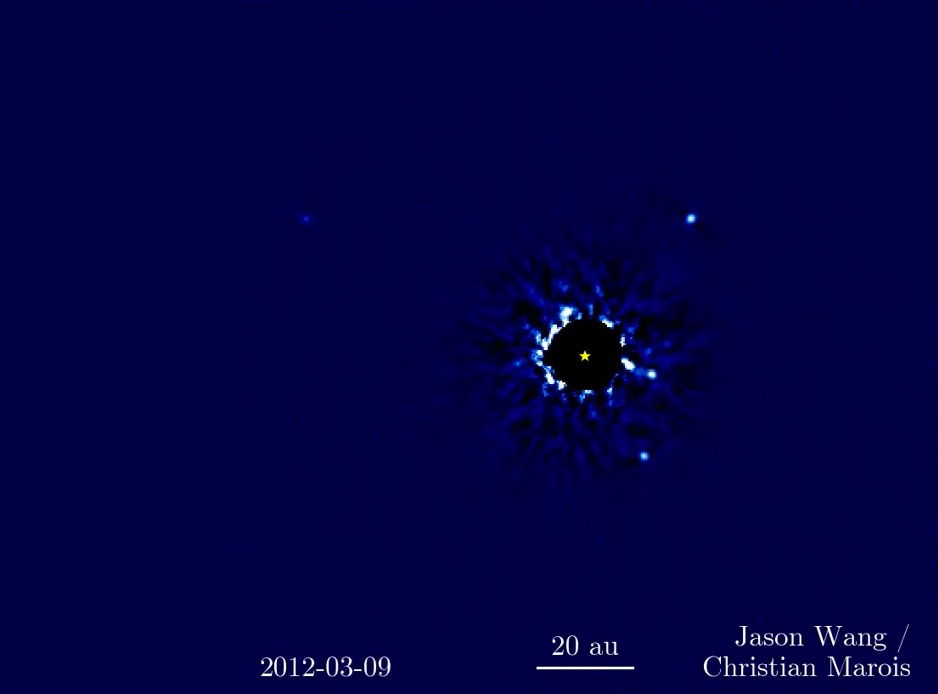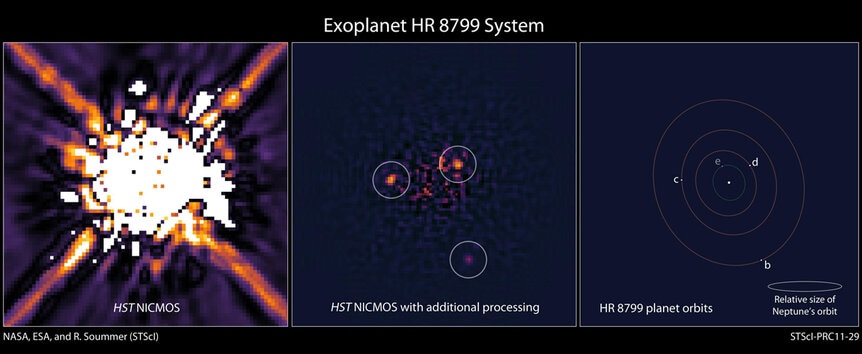Create a free profile to get unlimited access to exclusive videos, sweepstakes, and more!
Watch alien planets dance from across the gulf of space

[The star HR 8799 has a system of at least four planets, and their motion can be seen as they orbit the star. Credit: Wang & Marois]
Speaking of alien planetary systems …
While TRAPPIST-1 was recently in the news, it’s not the only exosolar system we know of. In fact, the first such system discovered was the very first confirmed discovery of exoplanets at all: In 1992, astronomers announced finding three small rocky worlds orbiting a pulsar, the remains of the core of a star that exploded long ago.
Over the next few years many more exoplanets were found, using a variety of methods. In 2004 a likely exoplanet was directly seen for the first time in an image of a star (I say “likely” because the mass of the object isn’t well known, and it might be big enough to qualify as a brown dwarf and not a planet). Since that time, many more have been seen, as well.
In 2008, a huge discovery was made: The nearby star HR 8799 was orbited by at least three planets (and a fourth was found later). The reason this was big is that all three had been seen directly in an image. Their existence wasn’t inferred; we saw them.
That system has been extensively and frequently observed since then. Over this time, the planets have been slowly orbiting their star, moving detectably. While inevitable, this part still fills me with awe: That motion can be detected in the images! Using the monster Keck telescope in Hawaii, astronomers were able to create an animation showing that motion:
I suggest slowing the video down to ¼ speed (click the gear icon at the lower right of the video) and set it to loop so you can easily watch it a few times, including the observation date clock ticking along.
Let me remind you: You are watching alien worlds orbiting a distant sun, their motion detectable across a thousand trillion kilometers of space.
I want to be careful here, and note that the motion you’re seeing has been morphed; the positions of the planets at each observation were noted and then interpolated to make the video smoother. Still, the overall motion of the planets is real.
You can see all four known planets in the HR 8799 system in the video (the fourth is to the upper left; put your cursor on it as the video runs to see its very slow orbital speed). The innermost of the four is still over two billion kilometers from the star; for comparison that’s a bit closer than Uranus is from the Sun. The other planets are much farther out.
All four are massive super-Jupiters. Still, they’re too small to be seen in reflected light of the star. We see them because they’re hot. The star and planets probably formed only about 100 million years ago or so, and the heat of their formation is still formidable. They glow in the infrared, which is how we can see them. Even then, sophisticated imaging techniques are needed to detect them against the brilliant glow of the star (which has been suppressed in the video for clarity).
This video is more than just eye (and brain) candy. It can be used to determine the orbital periods of the planets! The most likely “years” for them range from 40 to about 400 years. It looks like at least three of the planets are in resonance, which means their orbital periods are simple ratios of each other (in this case, 1:2:4). We see that in many systems, including Jupiter’s big Galilean moons (Io, Europa, Ganymede, and Callisto). As the planets first form and tug on each other, they can migrate away from or toward the star, and if they hit this resonance, they can become stable gravitationally and stay that way.
The dance of gravity we see in our own solar system is not unique, but instead is replicated over and over again on different scales throughout the Universe. How about that?
We’ve seen other exoplanets move around their stars over the years, including the super- Jupiter Beta Pictoris b (and that motion may wind up revealing the presence of moons orbiting the planet if we’re lucky). It’s one more technique in our arsenal of understanding alien planets, and one that, happily, tickles our brains and sense of wonder. To be able to see these planets in images, and see their motion...this is a terrific advance, and one that we will only get better at with time.



























